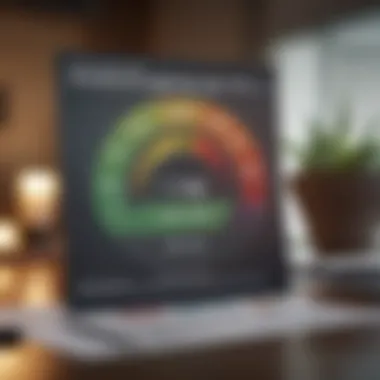Understanding a Credit Score of 612: Key Insights


Intro
Navigating the world of credit can feel like wandering through a maze, especially for those with a credit score of 612. This score, nestled in the middle of the credit score range, acts as a pivotal point for various financial opportunities. For young professionals, families, and students, understanding the implications of this specific score is crucial as it directly impacts financial decisions and future opportunities.
A credit score of 612 suggests that the individual in question is seen as a moderate risk. This perception can shape everything from securing loans to obtaining insurance. Furthermore, it's not just about the numbers; multiple factors contribute to this score, including payment history, credit utilization, length of credit history, types of credit used, and recent inquiries. To make informed decision about their finances, individuals need to grasp how these elements intertwine to create their overall credit profile.
Throughout this article, we will delve into the nuances of a credit score of 612. We’ll look at relevant financial products, application processes, and costs associated with loans and mortgages, while also dispelling common myths that can cloud judgment. From a detailed analysis of the features and benefits of financial products to practical strategies aimed at improving one’s score, this guide will illuminate the path towards better credit health.
Preamble to Credit Scores
Understanding credit scores is essential, especially for individuals navigating the labyrinth of modern finance. These scores, usually ranging from 300 to 850, play a crucial role in determining one’s creditworthiness. For a score of 612, it's vital to grasp how this number can shape financial opportunities and decisions. A credit score can be the deciding factor in getting a mortgage, an auto loan, or even a rental apartment. When lenders assess risk, your score is often the first piece of information they consider, which directly impacts the interest rates offered and terms available.
Moreover, knowing the components that contribute to your score can empower you to take actionable steps toward improvement. Different factors like payment history and credit utilization contribute significantly to this number and awareness of them is crucial. This section sets the stage for a deeper dive into what a credit score entails, allowing readers to visualize the importance of maintaining it in top shape.
Lastly, it’s vital to recognize that many misconceptions abound regarding how these scores are calculated and what influences them. Clearing up these inaccuracies not just helps individuals make informed decisions but also prepares them for healthier financial habits going forward.
The Implications of a Credit Score
A credit score of 612 finds itself nestled in what many would call the no man's land of creditworthiness. It's notable enough to get some attention but low enough to warrant caution from lenders. Understanding the implications of such a score is crucial for anyone navigating the credit landscape. The impact reverberates through various financial situations—from loan approvals to interest rates. This section dives into how a 612 score can influence your financial life and what you should keep in mind when facing credit-related decisions.
Overview of Credit Score Ranges
Credit scores can be simplified into ranges that indicate overall credit health. Most scoring systems categorize scores into five primary segments:
- Excellent (800-850): Lenders view these individuals as the most reliable. They usually receive the best terms.
- Good (700-799): This range is favorable and often translates into better interest rates.
- Fair (650-699): Many lenders will consider applicants in this range, but possibly with higher interest rates.
- Poor (580-649): At this level, obtaining credit becomes challenging, and if it's available, expect less favorable conditions.
- Very Poor (300-579): This category is where most mainstream financial institutions hesitate to lend, requiring significant credit repair efforts.
A score of 612, while sitting comfortably in the fair range, strikes a precarious balance. It’s right on the cusp where your positioning can shift dramatically. Just pausing to reflect on these ranges provides insight into how lenders perceive risk and make decisions.
Comparing a Score to Other Ranges
To truly understand the implications of a 612 score, it’s vital to position it against the backdrop of other score ranges. For instance, having a score of 612 means your financial path likely goes down a slightly bumpier road than someone with a score in the 700s or 800s. Here’s how it stacks up:
- Loan Opportunities: A score of 612 may land an applicant with limited loan offers. Lenders may require larger down payments or impose higher interest rates. The difference can add up to thousands over the loan's lifetime.
- Mortgage Rates: Interestingly, even those just scraping above 620 might find mortgage offers that are more enticing. A score of 612 might lead to a frustrating scenario where potential homeowners miss out on some desirable options.
- Credit Card Offers: Individuals with a score of 612 can struggle with credit card approvals and often face higher annual fees. Cards geared toward rewards or cash back typically evade this demographic, often leaving only basic options available.
In light of those comparisons, it becomes clear that while 612 is not a dreadful score, it certainly presents its own set of challenges. Sustaining that score warrants ongoing attention to financial habits.
"In the game of credit, every point counts, and a 612 becomes a reminder to keep an eye on the scoreboard."
Understanding these nuances surrounding a 612 credit score can help individuals strategically manage their finances and make informed decisions to work towards a stronger credit profile. Though it might not be easy, recognizing these implications is the first step toward improvement and empowerment.
Factors Influencing a Credit Score
A credit score of 612 lies in a territory that can pose challenges for individuals when it comes to securing favorable financial products. Understanding the various factors that weigh into this score is crucial for young professionals, families, or students who aim to improve their creditworthiness. Key elements such as payment history, credit utilization, length of credit history, types of credit accounts, and recent credit inquiries all play pivotal roles in shaping one’s credit profile. By dissecting these elements, individuals can take specific actions aimed at enhancing their scores over time, fundamentally altering their financial landscape.
Payment History
Payment history carries the most weight in determining a credit score. This component essentially reflects how reliably a person pays their bills, from credit cards to mortgages. For someone with a 612 score, any missed or late payments could have severely impacted this figure. Just one late payment can set off a ripple effect, leading to higher rates and less favorable terms for a future loan.
Focusing on consistent payment habits can directly influence improvement. Setting up automatic payments or reminders can help ensure that bills are settled on time, safeguarding against accidental lapses that can snowball into long-term credit damage. Additionally, maintaining open communication with creditors during financial difficulties can sometimes offer solutions like temporary payment relief without placing an undue strain on one’s credit record.
Credit Utilization
Credit utilization measures the ratio of current credit balances to the total available credit limit. In simpler terms, it's all about how much of your credit you're actually using. A general rule of thumb suggests trying to keep this ratio below 30%. With a credit score of 612, it’s likely that utilization is trending higher than optimal. This aspect can drastically lower a credit score if one is consistently maxing out credit limits.


To tackle this, it's advisable to pay down existing debts instead of accumulating more. Also, consider requesting credit limit increases on existing accounts. This can lower the utilization ratio without needing to increase spending. This strategy must be balanced with general responsible spending to avoid falling into debt.
Length of Credit History
The length of credit history, surprisingly, isn't about how much credit one has in total but how long someone has been managing credit responsibly. Lenders prefer to see a longer history, as it gives them a clearer sense of a borrower’s behavior. A score of 612 might suggest a relatively new history or one marred by instability, like increased debts or missed payments.
For those looking to improve, maintaining older accounts, even if they're not frequently used, can bolster this history. It's like fine wine; the longer it sits, the better it becomes—wiser credit behavior over an extended period reassures lenders of one's responsible financial habits.
Types of Credit Accounts
Diversity in credit accounts can also positively impact a credit score. This aspect pertains to the mix of credit---for example, having a blend of credit cards, installment loans, and retail accounts can signal to lenders that an individual can manage different types of credit responsibly. A score of 612 might reflect a narrow mix, leading to missed opportunities for score enhancement.
To foster an improved mix, consider diversifying one’s credit portfolio judiciously. However, this should be approached with caution—only take on additional credit when it aligns with stable financial management. Jumping from credit account to credit account recklessly can lead to increased inquiries, further hurting the score.
Recent Credit Inquiries
Recent credit inquiries arise when lenders check a person's credit report for the purpose of a loan or credit approval. This can be a double-edged sword. While it’s normal to have some inquiries, an excessive number within a short period can signal potential financial distress and negatively affect a credit score. With a score resting at 612, one might have more inquiries than ideal, further pressing down the score.
It’s wise to make inquiries sparingly. Instead of applying for every offer that comes along, it’s better to evaluate needs carefully and assess offers that truly align with one's financial situation. Additionally, researching can be done without an inquiry by checking pre-qualification options from lenders.
In summary, understanding the intricate factors influencing a credit score of 612 opens avenues for improvement. From altering spending habits to maintaining older accounts, the path to credit rehabilitation lies within grasp. Engaging in healthy financial practices not only enhances one's score but also bolsters future financial opportunities, setting the stage for more favorable terms and less financial strain.
Impact on Financial Products
Understanding how a credit score of 612 impacts financial products is crucial for anyone navigating their financial future. A score in this range often acts like a double-edged sword. On one side, it can open some doors; on the other, it may slam a few shut. Knowing the implications can help individuals tailor their financial strategies to maximize opportunities and minimize setbacks.
Loans, mortgages, credit cards, and even insurance premiums can all be influenced by a credit score of 612. Therefore, it becomes essential to dissect how this number shapes each of these products, providing a clearer picture for young professionals, families, and students alike.
Loans and Mortgages
A credit score of 612 can significantly impact one’s ability to secure a loan or mortgage. Generally, lenders view this score as being in the borderline area between fair and good—so it is neither here nor there. More often than not, you might find yourself facing higher interest rates. This can mean the difference between a manageable monthly payment and one that nibbles away at your budget.
When applying for a mortgage with a score of 612, the lender may request a larger down payment. This could mean parting with a hefty sum upfront if you’re looking at your dream home. Aside from that, terms can vary, and you may be subjected to stricter conditions or additional fees. In essence:
- Higher Interest Rates: Expect to see rates significantly above the average.
- Increased Down Payments: Lenders may require more cash upfront, depending on various factors.
- Limited Loan Options: Some lenders may steer clear of lower scores altogether.
Credit Cards
Credit cards are another financial product that reflects the reality of a 612 credit score. While it is still possible to obtain a credit card with this score, many people may find their options limited to secured credit cards or cards with lower credit limits and higher fees. This can feel like being put in a box, where the freedom to choose is lacking.
When applying for a credit card with a score of 612, keep in mind the potential drawbacks:
- Higher Fees: Annual fees or service charges may throw a wrench in your plans.
- Lower Credit Limits: Card issuers might not extend as much credit, limiting your purchasing power.
- Less Reward Opportunity: Many reward programs are out of reach for those with lower scores, with offers often aimed at users who consistently demonstrate reliability.
Insurance Premiums
Surprisingly, a 612 credit score can also stretch its influence over insurance premiums. Insurers frequently use credit scores when calculating rates for auto and home insurance. A lower credit score can lead to elevated premiums, making it feel like a tug-of-war between affordability and necessity.
Individuals with a score of 612 should be aware of the following factors regarding insurance:
- Higher Premiums: You may not get the best rates simply due to your credit score.
- Insurance Denials: In some extreme cases, insurers may deny coverage altogether based on perceived risk.
- Variable Coverage Offers: The terms of the policy may change when your credit score indicates greater risk.
"A credit score of 612 can be a sticky wicket; understanding its impact on financial products helps navigate the complex landscape of personal finance."


In summary, a credit score of 612 carries weight in the financial landscape. From obtaining loans to securing credit cards and insurance policies, the implications are extensive. Understanding these factors can guide individuals to make informed decisions and take proactive steps toward improving their credit scores for a healthier financial future.
Strategies for Improvement
Navigating the path to a better credit score involves deliberate actions and informed decisions. For someone with a credit score of 612, improving this number can unlock a spectrum of opportunities. It is a journey filled with strategies that revolve around disciplined financial habits and smart credit management. Let's delve into specific strategies that can help elevate a credit score.
Timely Bill Payments
One of the simplest yet most effective strategies to improve a credit score is to ensure timely bill payments. When bills are paid on time, creditors view this as a sign of reliability and responsibility. Abrupt failures to meet deadlines, on the other hand, can send a score plummeting like a bad penny.
Consider setting up automatic payments or reminders on your phone. This small adjustment in routine can make a world of difference. Even a minor slippage can reflect badly on your credit history; keep in mind that payment history constitutes approximately 35% of a credit score.
Reducing Credit Card Balances
High credit card balances can act like an anchor weighing down your score. A good rule of thumb is to keep your credit utilization ratio below 30%. This means if your limit is $10,000, it's best not to exceed $3,000 in outstanding balances.
To trim those balances, start paying off the cards with the highest interest rates first or focus on the ones with the highest utilization ratio. This can help clear the air around hefty debts, and while it may take time, the long-term effect on your credit score will be worth the effort.
- Consider a structured plan for payments. Making small, consistent payments can keep your usage balanced.
- Avoid unnecessary charges that can escalate your balance.
Avoiding New Credit Applications
Every time an individual applies for credit, it results in a hard inquiry on their credit report. Too many of these inquiries in a short period can trigger alarms and signal to lenders that you may be in financial distress. For someone already sitting at a 612 credit score, this can do more harm than good.
Before making new applications, weigh your options thoroughly. If possible, consolidate existing debts instead of taking on new ones. This also emphasizes the importance of knowing your current standing before diving into further credit commitments. A score improvement takes time; hence, patience is a vital component in this step.
"Your creditworthiness isn't just about numbers; it's a reflection of your financial habits and choices."
By focusing on these strategic elements, individuals can witness a genuine improvement in their credit scores. It’s important to remain steadfast and patient, as meaningful change often takes time. Every small step counts toward building a robust financial future.
Common Misconceptions
Understanding common misconceptions surrounding credit scores is vital for anyone looking to improve their financial health. Too often, individuals harbor misunderstandings that can lead to poor financial choices, which in turn can keep their credit scores stuck in a rut. By clearing the air, we can empower readers—especially young professionals, families, and students—to make more informed decisions.
Impact of Income on Credit Scores
A prevalent myth is that a higher income equates to a better credit score. However, this assumption is not accurate. Credit scores are designed to evaluate credit behavior rather than personal income.
- Payment History: This is the biggest factor in determining your credit score. Whether you earn a high income or not, missing payments will negatively impact your score.
- Credit Utilization: This reflects how much of your available credit you are using. If someone with a high salary has a high utilization rate, their score could still be in the dumps.
- Length of Credit History: A long credit history can enhance your score, regardless of income. Even rich folks can be in credit purgatory if they haven’t built a solid history.
Income can provide more options for managing debt but does not directly influence one's credit score. Thus, focusing on good credit habits is the surest way to improve your score.
The Myth of Credit Repair Services
Another significant misconception is about credit repair services. Many individuals believe that paying for these services will magically boost their scores. In reality, these companies often offer nothing more than information that users can obtain themselves.
- Self-Management: Individuals can dispute inaccuracies on their credit reports without hiring a third-party service. A little effort can go a long way.
- Understanding Rights: The Fair Credit Reporting Act gives everyone the right to access their credit reports and challenge errors. You don’t need an expensive service for that.
Remember, there’s no quick fix when it comes to credit scores. It takes consistent effort to improve them, and the right knowledge about how credit works is crucial.
Credit repair services might mislead consumers into thinking that external help is necessary for achieving a high score. The best approach is to educate oneself about credit scoring factors and clean up one’s credit health independently.
Clarifying these myths sets the foundation for a more proactive approach to managing one’s credit score. This understanding is especially important as the financial landscape continually evolves.


The Role of Monitoring and Educational Resources
In the realm of personal finance, understanding the nuances of credit scores can feel like navigating a labyrinth. For individuals with a credit score of 612, this understanding becomes paramount. Monitoring and educational resources serve as compasses in this journey, guiding individuals to better credit health.
Monitoring services provide real-time insights into your credit profile. They alert you to any significant changes when they occur—from new accounts to late payments. This proactive approach can help you catch errors or potential identity theft before they wreak havoc on your credit score. By utilizing these services, you not only stay informed but can also respond to issues swiftly, potentially mitigating damage to your score.
"Staying ahead of financial challenges is often better than fighting them once they arise."
Educational resources also play a critical role. Numerous platforms offer courses, articles, and webinars addressing the various aspects of credit management. Proper education equips individuals with the knowledge to make informed decisions. Knowing what factors influence credit scores, such as payment history, credit utilization, and the length of credit history, empowers people to take control of their financial futures.
Key Benefits of Monitoring and Educational Resources:
- Informed Decision-Making: By understanding credit scores, individuals can make choices that positively impact their financial standing.
- Financial Responsibility: Education helps in fostering a mindset of accountability and responsibility with respect to credit usage.
- Customized Strategies: Resources tailored to specific credit situations can guide individuals through personalized strategies for improvement.
Utilizing Credit Monitoring Services
Credit monitoring services have become a staple for those aiming to maintain or improve their credit profiles. These services typically involve tracking your credit report and score from major credit bureaus like Equifax, Experian, and TransUnion.
The foremost advantage of these services is the immediate notification of any changes in your credit report. For example, if a new account is opened in your name without your awareness, you’re likely to be informed right away. This early detection enables you to address issues like fraud, improving your credit safety.
A few notable features of credit monitoring services include:
- Credit Score Tracking: Regular updates on your score can provide insight into how your actions affect your credit profile.
- Expense Management: Many services combin the monitoring of credit cards and loans, helping you keep an eye on overall spending and payment trends.
- Credit Report Analysis: Some services offer thorough analysis of your credit report, pointing out derogatory marks and suggesting remedies.
Although these services may come with a fee, the cost can be viewed as an investment in your financial security. Given the implications that a credit score of 612 can have on your financial opportunities, it is often worth the expense.
Financial Literacy Programs
Financial literacy programs have gained traction as vital tools for those navigating their credit journeys. These programs encompass a broad spectrum of learning, from foundational concepts of credit to advanced strategies for improvement. They cater especially well to younger individuals or those who may have never received formal education on managing their financial health.
Participating in such programs can impart crucial lessons:
- Understanding credit scores and their significance
- Learning about the impact of debt on financial health
- Identifying effective practices for budgeting and saving
Moreover, many programs now integrate technology, offering interactive platforms that provide virtual learning spaces. This adaptability makes financial literacy more accessible than ever, especially for those with busy lifestyles.
People often engage in community-sponsored workshops or online courses, allowing for flexibility and a tailored approach. Essential elements that participants find beneficial include:
- Real-Life Scenarios: Many programs utilize case studies, helping attendees relate the material to their personal situations.
- Expert Guidance: Facilitators often share personal stories or expert insights, making lessons more impactful.
- Networking Opportunities: Engaging with peers can help form community support systems where individuals can share experiences and resources.
Ultimately, the combination of monitoring and education fosters a holistic approach to credit management. In a world where a credit score can open or shut doors, investing time and effort into these resources can unlock greater financial opportunities.
Ending
The conclusion of this article ties together the intricate threads of understanding a credit score of 612. This score, positioned at the lower end of the average range, carries significant implications for individuals navigating their financial lives. It is essential to recognize that while a score of 612 may pose certain challenges, it also opens up avenues for improvement and growth.
Recap of Key Points
To distill the information presented:
- Understanding Credit Scores: A credit score serves as a vital indicator of financial health, affecting loan eligibility, interest rates, and more.
- Implications of a 612 Score: Such a score can lead to higher borrowing costs and limited access to premium financial products.
- Factors Influencing the Score: Payment history, credit utilization, and the types of credit accounts are key areas that have an impact.
- Strategies for Improvement: Consistent, on-time payments and reducing credit card balances were highlighted as effective methods for boosting scores.
- Common Misconceptions: Many believe that income directly influences credit scores, which is not accurate. This understanding is crucial for making informed decisions.
- Monitoring Progress: Utilizing monitoring services and engaging with financial literacy programs can be critical for those aiming to improve their scores.
Final Thoughts on Managing Credit Scores
Management of a credit score is not a one-time event; it’s a continuous effort. Individuals should approach their credit profiles like a garden, requiring regular attention and care. Maintaining a score in the low to mid ranges means embracing habits that foster improvement.
As young professionals or families, it's advisable to make a conscious effort to understand the nuances of credit scores and their implications.
- Stay Proactive: Regularly check your credit report for inaccuracies and understand where improvements can be made. Keeping track can help you spot red flags before they become significant issues.
- Educate Yourself: Financial literacy isn’t just for economists. Engaging with resources, whether online forums like Reddit, educational programs, or insightful articles, can empower you to make knowledgeable decisions.
- Develop Strong Financial Habits: Focusing on paying bills on time and keeping credit utilization low can drastically transform a score over time.
Ultimately, the journey to better credit is one of resilience and informed choice. Each individual has the potential to improve their standing, one step at a time. Emphasizing education and strategic choices can turn the narrative around a credit score of 612 into a story of triumph.



